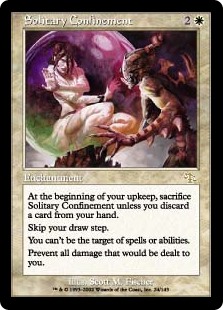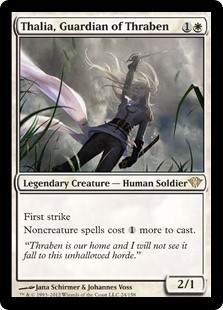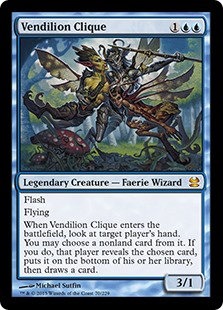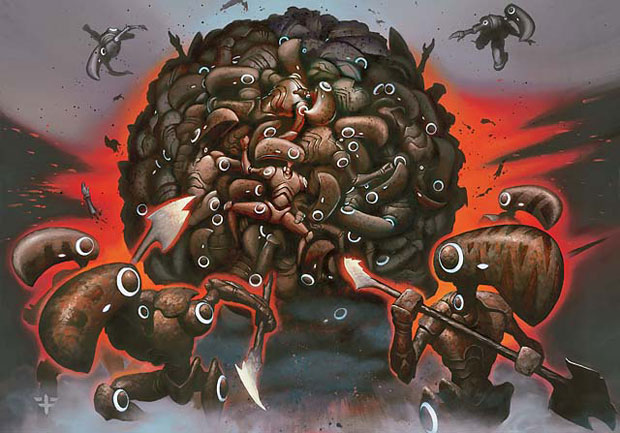THERE IS NO BUBBLE! LONG LIVE THE BUBBLE!
There has been a lot of talk over the last couple of months about the rising cost of playing Modern and Magic: The Gathering in general. Some doomsayers, including one on this very site, have gone so far as to say that we should be selling our Modern cards and heading for higher ground.
This is a long and detailed article but let me sum things up as follows: Modern’s likely user growth will more than counter any negative interest generated by rising deck costs. The economics of the brand, the company that owns it, and the demographics of our community bear this out. Read on and I’ll explain.
Here in a nutshell is a deconstruction of common logic fallacies, false facts and misinterpreted theories that are commonly offered up on the topic of Modern in specific and Magic in general, and how you, as an MTGfinance investor can avoid falling into these traps that could ultimately cost you money.
1) (Modern) Magic Is In A Bubble & It’s About to Burst
Rest easy. Nothing could be further from the truth, but first we need to define what a bubble actually represents from the perspective of economics:
“An economic bubble (sometimes referred to as a speculative bubble, a market bubble, a price bubble, a financial bubble, a speculative mania or a balloon) is “trade in high volumes at prices that are considerably at variance with intrinsic values”. It could also be described as a situation in which asset prices appear to be based on implausible or inconsistent views about the future.”

To provide an example, the economic crisis that hit the global economic system in 2008 was largely due to market manipulation on mortgage derivatives products that had been constructed to bet against the mortgages taken on by families with low incomes and/or bad credit, at abnormally low interest rates, on the premise that the home owners would default on those loans once interest rates rose again. At the core of the issue was a so-called “housing bubble” wherein housing prices in the US rose dramatically as many Americans chased the dream of house ownership without ever doing the math. When the economic conditions (low interest rates) collapsed in response to the crisis, a bubble was declared as housing prices snapped back to levels from several years earlier due to tens of thousands of home foreclosures across the country and the subsequent increase in supply of cheap homes, found as a result of banks unloading homes they had foreclosed on.
So what’s that got to do with Magic you say?
Well, for Modern as a format, or even Magic: The Gathering in general to be in a “bubble” would suggest that there is something inherently unstable and unsustainable to be found in the structure of the game, the products required for it to be played and it’s economic fundamentals. To recognize such a bubble we should be on the lookout for abnormally high volumes of economic activity, a growing gap between intrinsic value and cost, and unjustified optimism. Absolutely none of this is true, so bear with me as we break it down.
Let’s take each relevant attribute of a potential bubble in turn and see what we’re really dealing with:
Stability: Magic: The Gathering is now a truly global brand being published in numerous languages, with a 20 year fan base, a strong growth curve, and being managed by one of the biggest toy companies on the planet. Remember, Hasbro has an excellent track record of growing and protecting multi-generational brands. They started MTGO a decade ago because they assumed video games would erode their TCG business and they wanted to be ahead of the curve. Instead, MTGO and Duals of the Planeswalkers added significant business rather than cannibalizing it, while reducing production and distribution costs. If video games haven’t killed paper Magic yet, it won’t be happening this decade.
Sustainability: Hasbro has largely stopped handing out simple sales figures but we can still figure out the growth math with some digging. Firstly, if we assume that the average Magic player spends a reasonable $75/annum (remember, most players are very casual and don’t spend at MTGFinance levels) and we have 6M current players, then total sales should be about $450M globally. From this NBC article last August, we can glean that of the 1.2B Hasbro is posting on games from Monopoly to D&D and Magic, Magic is producing roughly 30-40% of that revenue as their biggest producing games brand. Let’s call it $400 million, which matches the other estimate above. And sales have been growing at 25%+ for the last 4 years, so we could easily top $500M this year, as reports on Theros sales were quite positive. These are astonishingly good numbers and consistent with other inferences in Hasbro investor reports I received, but still a drop in the bucket vs. attainable market size.
Now, compare these figures to the video gaming industry at $50B just in the US, and $100B globally and you’ll realize that Magic can keep grabbing market share from other nerd entertainment hobbies for years without running out of room for growth. Continuing growth in the middle class of developing countries like China will also help because middle class attainment equals free time and money spent on hobbies.
(It should be noted that when looking at this as a $1B+ business, counting the secondary market, the random activities of our MTGFinance community don’t count for shit. The average spec I hear humble-bragged on Twitter is a $50 upside, which is a joke vs. the big picture. Let me be clearer, MTGFinance CANNOT crash this business, no matter how hard we try. Even the vendors don’t have that power as there will always be a market actor that will step in to accept lower margins and ultimately Wizards can wield reprints and various tools on a limited basis to keep decks within reach.)
Intrinsic Value: I have seen it stated in several MTGFinance articles that Magic cards have no intrinsic value. This is in many ways used to suggest they have no utility, which is clearly false. Magic cards are entertainment goods, like sports equipment, my PS4, and MP3s downloaded from ITunes, and as such, are one of the most consistently valuable goods in the western world where recent generations have established free time and the pursuit of hobbies as crucial to an acceptable lifestyle. A movie and popcorn costs $25 and they’re posting banner sales figures. $25 worth of Magic cards is equivalent to plenty more hours of entertainment, though perhaps not at a Modern tournament. Still, looking at cost/hour of entertainment, Modern just isn’t that expensive and the fun factor of big tournaments is high, which is why we’re willing to travel to them and make a weekend out of it.
SUMMARY: There is no price bubble in Modern. Rather prices are rising naturally to meet demand which is a sign of a healthy market and a growing game.
2) Modern is too expensive
This fallacy indicates a lack of comprehension of just how good Hasbro/Wizards is at performing demographic research, predicting product demand and setting relevant price points for their products.
Hasbro is a multi-national corporation and they are marketers of world class calibre. This is the company that controls licenses on Star Wars, Transformers, GIJOE and Monopoly. As far back as the late 90s I remember seeing a survey result from Wizards indicating that the average player was spending over $1000/annum on the game. This game is predominantly played by middle class and upper middle class white males from the suburbs. So long as they keep the average cost of participation under $2500/annum, they’ll continue to do just fine. Also, if the average Modern card is now more expensive, it’s a simple reflection of the fact that the community has been redirected over the last 18 months to engage with this fresh new format. In short, demand is rising.

Reflect for a moment, on how new Magic players are eased into it. “All you need to play is this Intro Deck at $15. Now try a Fat Pack or Event Deck at $35. Your first booster box will run you $100. Your first Standard deck will be about $300. Your Modern deck is going to run you $500-$1000.”
From a format perspective they lead us from the kitchen table or Duels of the Planeswalker, to Friday Night Magic, to drafts, MTGO and local tournaments, then on to Grand Prix events with travel and hotel expenses.
None of this is by accident folks.
In economics we talk about Price Elasticity, the ability for a price to be raised or lowered without effecting demand. Trust me, if you hear about people quitting Modern because they can’t afford it, Wizards economic modelling will already have calculated that their retreat is acceptable in the grand scheme of things, especially if they switch back to limited formats that move more product in the current sales cycle.
The rising cost of a small percentage of tournament quality singles on the secondary market is absolutely meaningless in any analysis of the price of playing Magic on the whole. Firstly, the vast majority of the economic action is in the primary Magic market (at retail) not the significantly smaller secondary market which is propped up by the most dedicated 10% of the community. Also, the cost of a pack of Magic cards has resisted inflation for most of the years since the initial release in 1993. I was buying 3 packs for $10 at 401 Games in 1998 and I still am today. In fact, the Internet has arguably made collecting far cheaper, as access to price data on MTGPrice.com, lowest common denominator pricing on TCGPlayer.com and access to $85 booster boxes have made smart purchases far easier to achieve.
Further, even at $500 for a Tier 2 Modern deck, the price really isn’t that high for something you can mostly reuse for most of a year and cash out at some point, likely for as much or more than you paid. Hell my snowboard, surf and skate gear in a given year all exceed $1K. That’s just what hobbies tend to cost and this game has the demographics to support that. Just look at a big Grand Prix like Richmond. The metagame was significantly warped on Day 1, mostly because the majority of players didn’t have access to Goyfs and Fetchlands and other expensive cards and wanted to try rogue decks they could easily build. It was still the biggest constructed tournament ever because players don’t need to be able to afford the best deck to be interested in playing Modern. They just need to have a shot at winning more than they lose and having fun with their friends. Only 8 people made the quarter-finals at Richmond, but the other 4500 people still had a blast by all accounts fooling around in side tournaments and testing their lower tier decks with other friends that dropped out.
Finally, we need to recognize that there is always a feeling of unfairness encountered when the price on a good rises. No matter what you’re buying you will feel ripped off if the price is higher than last week. However, there is never a “right price” on any good. If a consumer is willing to pay the price, the price must be inherently correct so long as no actual misrepresentation of the good has occurred. The funny thing is, only YOU control your own utility value for a good. If you think something is too expensive, DON’T BUY IT. This is the only way to send the correct market signals. Before you blame SCG for raising Magic prices, remember that every player that buys from them at a premium had a multitude of alternatives and still felt the price was acceptable. If Modern is too expensive for you, it means the cost of participating is higher than your next closest alternative activity, assuming it provides equivalent satisfaction and value/hour of entertainment.
SUMMARY: Modern is actually relatively affordable for a hobby even now, players can play cheaper decks if they need to, and even if that wasn’t true Wizards would see it coming and adjust accordingly without killing the whole format.
3) Reprints are coming!
This is true, but it will be limited, well measured and the secondary market will be largely insulated from it by the growth of the game. Wizards has repeatedly expressed a willingness to keep Modern (and Magic in general) propped up by card availability. Note that this is very different than a commitment to making the format affordable! Remember, Modern was NOT designed to be the primary play style for Magic as a whole. From within the Magic tournament and/or MTGFinance communities it is easy to build up a myopic view of the game, so it’s important to remember that over 90% of all Magic cards are being played casually at the kitchen table and at small local tourneys and play groups. We’re breaking records for tournament attendance at nearly every Grand Prix this spring, but even GP Richmond and GP Vegas failed to break 5000 players. That’s vs. the approximately 6,000,000 people on the planet now playing Magic. Add up all the tournament players at all the tournaments on the planet and you still get something under 1M, many of which would be repeat players. You also need to consider that the growth rate of the game has been 25% for the last 4 years or so. This means we’ve gone from roughly 2M to 6M players in four years and that the average Magic player (4M people!) has been playing for less than 2 years.
I cannot stress enough how crucial this point is to understanding the economics of Magic.
Modern has been labelled by Wizards as the format for experienced players that have been playing for 3-4 years. Magic is sold at Walmart, at Target, on Amazon, and Ebay to people who are still trying to memorize all the rules and keywords, who don’t have playsets for Standard, let alone Modern, and who care more about learning the game than winning a Grand Prix for now.
This means that so long as Magic continues to grow at a reasonable pace, we are facing a massive influx of additional Modern interest and card demand within the next 2-3 years, and that demand will be constantly increasing. 
It also means that reprintings are not likely to reduce the cost of playing Modern, as the goal of the format and relevant reprints will be to ensure that decks can be made and played in great variety, and not that they are all available cheaply. If demand increases steadily then new card supply will not reduce prices on staples, only lower tier cards whose demand was only propped up by relative scarcity. An analysis of Modern Masters bears this out with key cards like Bob and Goyf rising a few months out from release, while lesser demand rares and mythics fell in price.
It’s important to recognize that Magic exists as a two-tier economy with Hasbro/Wizards at the top designing, developing and marketing multiple products per year for the Magic community, as well as running or supporting the tournament scene at multiple levels to provide structure, goals and a community that furthers their objectives of keeping players engaged and buying primary product.
The second tier is composed of the LGS system, mass market retailers, comic shops, online vendors and the (by comparison tiny) MTGFinance types that deal in the secondary resale of Magic products, largely to each other. Money from the secondary market literally never flows upstream to Wizards/Hasbro, it just circulates in the community and leaves occasionally when people cash out to leave the game or for personal reasons. It is however a big part of why many of us are willing to invest in the format and the game, and why higher deck prices won’t kill Modern or Magic. If I could sell my old snowboard for what I paid or more every year I’d be stoked. What does a $1K deck matter, if I can cash out at $1.4K later and get paid to play? Even if my decks value is cut in half through wear and meta-gaming, that’s pretty good. How many hobbies have this kind of intrinsic investment potential? Virtually none, though my toy and stock portfolios beg to differ.
This is important, because it means that the price of a Tarmogoyf or Scalding Tarn is only relevant to Wizards/Hasbro if the price decreases total primary sales. Ultimately the corporation answers to shareholders like me, and we only care about profits, or at least the system is only set up to make it seem like that’s the case. As such, there is no direct compulsion to ensure Magic cards stay cheap. In fact, on the contrary, the corporation is actively trying to get us to spend more on the game every year.
Once upon a time we got a few sets a year, core sets were all reprints and came out every couple of years and specialty products were incredibly rare. Now we’re virtually guaranteed a 3 set block, a core set, a summer specialty set, and FTV, multiple Commander products, theme decks, block decks, and a wide variety of promotional items. Over it’s 20 year history, the game has expanded to include multiple video game versions, with Duels of the Planeswalkers being especially notable for driving a significant portion of the new business on the physical side of the game over the last few years via exposure on the Apple and Android stores, as well as on PS3 and Xbox.
This is also not a binary situation of reprint or not. We often forget that they best tool available to Wizards is not reprints, but also card variety, power creep, silver bullets and support for multiple formats. The design/dev team is fully plugged in these days to the various formats and how to provide cards in each product to accommodate them. By slowly offering up new and varied cards and card types (think Planeswalkers or Rest In Peace) they can help keep a format fresh and diverse. Silver bullet cards designed to target certain dominant deck types also do work, as does the occasional banning or unbanning. Subtle power creep over time invalidates older cards in droves and forces us to buy newer cards to stay competitive.
Finally, Wizards works 2-3 years in advance now. As such, the current situation with after-market price increases in Modern staples is only going to yield product level changes on any kind of a large scale from 2016 forward. Sure, we’re going to get 5-10 key staples reprinted in 2014, and if things really get out of hand they may ratchet up the offerings, but again, this will only be due to the presence of equivalent demand that will swallow up the cards. It’s also tough to print a lot of the cards that have strong thematic elements that bind them to their original block and speciality sets, limiting their total options somewhat. So will we lost some cash on reprints? Definitely. But the growth in the game will keep our overall portfolio rising regardless. Diversify and you’ll be fine.
SUMMARY: Reprints are slow to produce, unlikely to temper prices on key cards, and the additional supply is highly likely to be met by equivalent demand.
4) No one got hurt selling for a profit!
As an economist, this makes me choke because it shows an utter lack of understanding of the concept of opportunity cost.
In short opportunity cost is the money you leave on the table when you push your investments in another direction. Here’s a little case study:
Eg) You brilliantly purchase 12 copies of Snapcaster Mage (Foil) in November 2013 for about $80/per. In March, 2014 you decide to sell your SMFs for $140 per, reaping a hefty profit of about $45/card post-expenses, and yielding an approximate annual return equivalent of 150%. Given that the average investment account only yields about 6% a year, you’re doing great.
The tricky part however is what to do next.

If you have a distinct personal need like a wedding, a new car or medical bills then the decision is a no brainer as your consumption needs will outrank your ability to invest. Many people see these scenarios as a win, and they can be, but they’re also a brick wall because you lose liquidity that costs you when future opportunities arise. Cars depreciate and weddings are anti-investments incarnate.
But if you can afford to reinvest your profits I strongly advise you against pulling out on Modern staples at present. This is not the same as indicting your specific sale. If you foresee a metagame shift and believe Snapcaster is on a down trend, by all means, dump. But make sure you know your next move to be better than where the money is currently parked! Don’t sell MTG cards to pay off a line of credit at 10% because MTG, invested wisely, can make far more than 10%. In essence you’re borrowing from your debt in the short term to pay off more debt later when you do this right. (We make a similar mistake when we ignore shipping, time spent at our hourly working rate and materials when calculating MTGFinance profits.)
So what should we be doing, if Modern is not in a bubble?
Well, firstly, you need to be tactical when deciding where your Modern investments could go wrong regardless of my arguments above. Fetches for instance are reasonably likely to get printed within the year as they are core to most decks across the board and would send a strong signal that Modern will be supported broadly. It’s also possible that the fall set will provide a fresh set of duals that will open up new deck building options at a cheaper entry price. You can still lose money in Modern, but you can make more if you’re smart about how you’re diversified.
Personally I’m balls deep on Modern staple foils. What’s your next move?
James Chillcott is a 20 year Magic veteran with a 1750 composite rating, an economics degree, and 12 years’ experience as a digital entrepreneur, marketing executive and business consultant. He’s also the co-founder of ShelfLife.net, The Future of Collecting.





